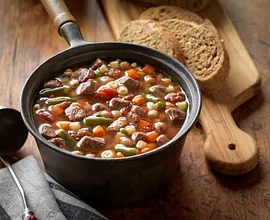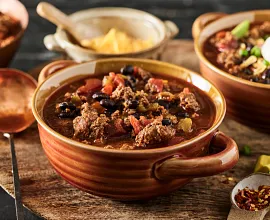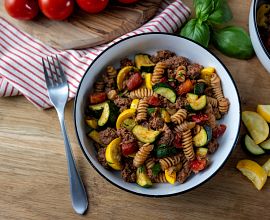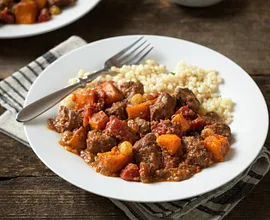Every bite your baby takes counts, especially in the first 24 months of life. Starting your baby with beef as a complementary first food can ensure they get the nutrients they need for healthy growth and development.
The American Academy of Pediatrics, the Women Infants and Children’s Program (WIC) and now for the first time ever, the Dietary Guidelines for Americans recommend introducing solid foods, like beef, to infants and toddlers, in order to pack in every bite with protein, iron, zinc and choline.1-5 Read on to learn how and why to incorporate beef through various life stages.
Serving nutritious foods babies and toddler love to eat, like beef, is simple and easy—puree, mash, chop or shred meat at various stages to meet their changing feeding needs.
Introducing Solids to Infants
A baby’s body grows tremendously in the first year: body weight triples, length more than doubles and the brain increases by 40 percent. A focus on food, nutrients and feeding skills are a high priority.
Experts agree that breastfed infants need a good dietary source of iron and zinc by 6 months of age, as their requirements for these nutrients cannot be met by breastmilk alone. One way to boost iron and zinc intake for your child is by introducing pureed beef as a complementary food, while continuing to breastfeed. Doing so may provide long-lasting benefits for your baby, such as developing a healthy immune system, improving recall skills and reasoning, as well as promoting growth and learning milestones.
Around 6 months of age, it is important to introduce nutrient-rich solid foods along with breastmilk or formula. The introduction of these first foods, also known as complementary foods, provides babies with the opportunity to experience new tastes, textures, colors and also teaches them how to enjoy food. Foods like beef can provide babies with a good source of iron, zinc, choline, B vitamins and protein, and can also provide them with a unique taste and texture experience.1, 6, 8-11
Babies are ready for solid foods if they:
- are about 6 months old
- sit up, with or without support
- have good head control
- seem interested in food
- no longer spit out solids
Infant Preparation and Feeding Tips
At around 8-10 months of age, babies develop a pincer grasp and learn to self-feed, making food textures, flavors and feeding methods — like traditional parent-led spoon feeding, baby-led weaning or a combined method — important considerations. For optimal health, make sure babies are meeting their nutrient needs, learning new feeding skills, and enjoying food. Sit with your baby when eating and monitor for choking.
Babies will start with thin pureed foods at around 6 months and advance to complex textures including chopped foods, finger foods and family food by the end of the first year.
Around 6 Months
When your baby is 6-8 months, they may be ready to make the transition from watery purees to smooth, pureed, single-ingredients foods such as pureed beef, pureed squash or pureed pears.
6-8 Months
In this stage your baby may be ready to transition to mashed, lumpy texture foods and combinations of single-ingredient foods. These include mashed banana or avocado, pureed beef and pureed green beans. Your baby may also be ready for soft, dissolvable finger foods like puffs, buttery toast or crackers.
8-10 Months
During 8-10 months of age your baby can transition to chopped table foods such as shredded or chopped beef, well-cooked pasta, chopped cooked veggies or soft-cooked beans.
10-12 Months
Between 10-12 months of age babies can start transitioning into chopped family food and practice with self-feeding using the spoon.
Additional Resources
Toddler Feeding Tips
Toddlers (1-3 years old) can be both a challenge and a joy to feed. Their growth slows after the first year, making their appetite large one day and non-existent the next. Toddlers also begin to understand the power of “no” and may test it with food. Fear of new food, food jags (eating the same foods) and picky eating are commonly seen during this stage of childhood. 1, 7-11
During this stage, it’s important to expose toddlers to a variety of nutritious foods so they learn to eat a balanced diet. It’s also important to meet nutrient requirements and transition to an eating routine. Some suggestions when feeding a toddler are:
- Include your toddler at the family table as often as possible. Research consistently supports the value and importance of family meals.
- Avoid making a separate meal for your toddler. Rather, plan meals and snacks with food variety in mind, including one or two foods you know your toddler enjoys eating.
- Offer a variety of foods from all food groups. Vary cooking methods, presentation, and flavor components. Repeated exposure without pressure to eat is the best way to encourage your toddler to taste and like new foods.
- Let your toddler decide between two food items (e.g., apple or banana, roast beef or turkey, cheese or yogurt), so they can contribute to decision making.
- Don’t pressure your toddler to eat more or try a new food. Pressuring a child to eat often backfires, leading to food refusal.
- Don’t sweat it if your toddler refuses food. Stay positive and consistent with the meal you have planned and try again another time.
Follow a daily feeding pattern similar to the foods listed in the chart below to provide the calories, protein, vitamins and minerals your toddler needs for healthy growth.
Eating Tips for Healthy Toddler Growth

Recipes for Tots
Beef Chili
This traditional chili couldn’t be any easier. Simply brown lean Ground Beef, add in pantry-friendly ingredients and simmer for 20 minutes. Omit green onions and cilantro if serving to early eaters (6-7 months). Toppings like avocado and shredded cheddar cheese provide a great opportunity for providing a variety of taste and texture to this dish for early eaters.
Ground Beef Pasta Skillet Primavera
This Italian-inspired recipe is a one-pot, fun to make and eat dish that combines ground beef, pasta, fresh zucchini and yellow squash. For early eaters (6-7 months), spaghetti can be hard to pick up prior to the baby having the pincer grasp. Pieces of pasta about the size of an adult pinky finger are preferable early on in self-feeding. These include rigatoni, penne, cavatappi.
Moroccan Beef and Sweet Potato
Use your slow-cooker to develop sweet and savory flavors in this Moroccan Beef Stew. For early eaters, use no-salt added diced tomatoes. Using no-salt added diced tomatoes is a smart switch for anyone with this recipe – that way, each individual can add salt to preference and taste.
Eating While Pregnant
During pregnancy, it is important to be mindful of your body’s need for more nutrients. Throughout pregnancy, your body needs about 10 extra grams of protein each day to support the growing baby. It is also important to get enough iron for red blood cell production, zinc for the baby’s brain development, choline to help build the brain and spinal cord, and B vitamins to utilize energy efficiently. Including just one additional high-protein snack (like half of a roast beef sandwich on wheat bread) will help you meet these important nutrient goals. 2, 12
Discover the importance of iron during pregnancy and beyond.
Here are a few ideas for quick ways to add some extra nutrition to your daily meals:
- Add a few additional ounces extra beef to your standard casserole and enjoy it all week
- Include beef jerky as a snack
- Serve scrambled eggs with a few ounces of taco-seasoned Ground Beef
- Ask for slices of grilled steak on your salad at lunch
- Load up your classic Ground Beef tacos with extra veggies and low-fat cheese
If you have questions about starting solid foods, consult your physician or health care provider.
- American Academy of Pediatrics. Pediatric Nutrition Handbook. 7th ed. Elk Grove, IL: American Academy of Pediatrics, 2014.
- Dietary Guidelines Advisory Committee. 2020. Scientific Report of the 2020 Dietary Guidelines Advisory Committee: Advisory Report to the Secretary of Agriculture and the Secretary of Health and Human Services. U.S. Department of Agriculture, Agricultural Research Service, Washington, DC.
- Schwarzenberg SJ, et al. Advocacy for improving nutrition in the first 1000 days to support childhood development and adult health. Pediatrics 2018;141:e20173716.
- USDA WIC Works Resource System. Infant Nutrition and Feeding Guide. https://wicworks.fns.usda.gov/resources/infant-nutrition-and-feeding-guide
- U.S. Department of Agriculture, Agricultural Research Service. FoodData Central, 2019. https://www.fdc.nal.usda.gov/fdc-app.html#/food-details/170208/nutrients
- Feeding Tips for Healthy Infant Growth. Jill Castle, MS, RD, LDN. https://beef.widen.net/content/xtwqxu78ar/original/Feeding-Tips-for-Healthy-Infant-Growth.pdf?u=q5atpk&download=true
- Eating Tips for Healthy Toddler Growth. Jill Castle, MS, RD, LDN. https://beef.widen.net/content/digozvwaip/original/Eating-Tips-for-Healthy-Toddler-Growth.pdf?u=q5atpk&download=true
- Nutrition Strategies for Infants and Toddlers. Robert Murray MD, FAAP, Jill Castle MS, RD, LDN. https://www.beefitswhatsfordinner.com/Media/BIWFD/Docs/nutrition-strategies-for-infants-and-toddlers_jill-castle-presentation.pdf
- Murray, RD. 2017. Influences on the initial dietary pattern of infants from birth to 24 months. Nutr Today 52: S25-S29. doi: 10.1097/NT.0000000000000195.
- Murray, RD. Fireside Chat: Why the Early Years? https://www.beefitswhatsfordinner.com/nutrition/early-years-e-vent
- Perez-Escamilla R, Segura-Perez S, Lott M. Robert Wood Johnson Foundation. HER Expert Panel on Best Practices for Promoting Healthy Nutrition, Feeding Patterns, and Weight Status for Infants and Toddlers from Birth to 24 Months. 2017. Feeding Guidelines for Infants and Young Toddlers: A Responsive Parenting Approach. In Healthy Eating Research: Building evidence to prevent childhood obesity. Durham, NC. http://healthyeatingresearch.org.
- Kominiarek MA, Rajan P. Nutrition Recommendations in Pregnancy and Lactation. Med Clin North Am. 2016;100(6):1199-1215.





